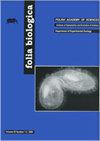下霞蝶-羽扇蝶物种复合体的Taxa(鳞翅目、睡蝶科、蝶亚科):尽管形态相似,但DNA条形码的深度差异
IF 0.8
4区 生物学
Q4 BIOLOGY
引用次数: 2
摘要
霞石藻属包括分布在古北界南部的约40种。在该属中,H.lycaon–H.lupina物种复合体的分类群在翅膀图案和生殖器结构方面相似。在这里,我们使用蝴蝶形态分析、DNA条形码和类型材料研究来修改这一组。我们发现,除了少数例外,这一群体中的物种在分布上是异地的。同种异体与表型相似性的结合在理论上可以被解释为这些分类群同种的证据。在这里,我们通过DNA条形码分析来证伪这一假设。我们表明,这种复合体的物种在基因上非常遥远,不能作为一个多型物种组合在一起。我们还证明了H.lupina由两个分歧很大的异父分支组成,H.lupina.s.和H.mauritanica combstat.nov.这些分类群之间的条形码p距离(3.4-4.9%)显著高于普遍接受的“标准”最小种间差异(2.0-3.0%)阈值。这两个分支也可以通过雄性翅膀上侧的颜色来区分(羽扇豆属的棕色,有明显的金色反射;毛额豆属的深棕色,没有金色反射),以及雄性生殖器和雄性雄锥结构的细节。本文章由计算机程序翻译,如有差异,请以英文原文为准。
The Taxa of the Hyponephele lycaon – H. lupina Species Complex (Lepidoptera, Nymphalidae, Satyrinae): Deep DNA Barcode Divergence despite Morphological Similarity
The genus Hyponephele includes about 40 species distributed throughout the southern part of the Palaearctic area. Within this genus, the taxa of the H. lycaon – H. lupina species complex are similar with respect to the wing pattern and genitalia structure.
Here we revise this group using analysis of butterfly morphology, DNA barcodes, and study of the type material. We show that, with a few exceptions, the species in this group are allopatric in distribution. Allopatry in combination with phenotypic similarity may be theoretically interpreted
as evidence for the conspecifity of these taxa. Here we falsify this hypothesis by using DNA barcode analysis. We show that the species of this complex are genetically very distant and cannot be combined together as a polytypic species. We also demonstrate that H. lupina consists of
two deeply diverged allopatric clades, H. lupina s. s. and H. mauritanica comb. & stat. nov. The barcode p-distance between these taxa (3.4-4.9%) is significantly higher than the generally accepted 'standard' minimum interspecific divergence (2.0-3.0% ) threshold. These two
clades can also be distinguished by the color of the upperside of the wing in males (brown with conspicuous golden reflection in H. lupina ; dark brown without golden reflection in H. mauritanica) and by details in male genitalia and male androconia structures. Syntypes of Hyponephele
sifanica, H. cheena cheena, H. cheena iskander, and H. cheena kashmirica are studied and figured.
求助全文
通过发布文献求助,成功后即可免费获取论文全文。
去求助
来源期刊

Folia Biologica-Krakow
医学-生物学
CiteScore
1.10
自引率
14.30%
发文量
15
审稿时长
>12 weeks
期刊介绍:
Folia Biologica (Kraków) is an international online open access journal accepting original scientific articles on various aspects of zoology: phylogeny, genetics, chromosomal studies, ecology, biogeography, experimental zoology and ultrastructural studies. The language of publication is English, articles are assembled in four issues per year.
 求助内容:
求助内容: 应助结果提醒方式:
应助结果提醒方式:


